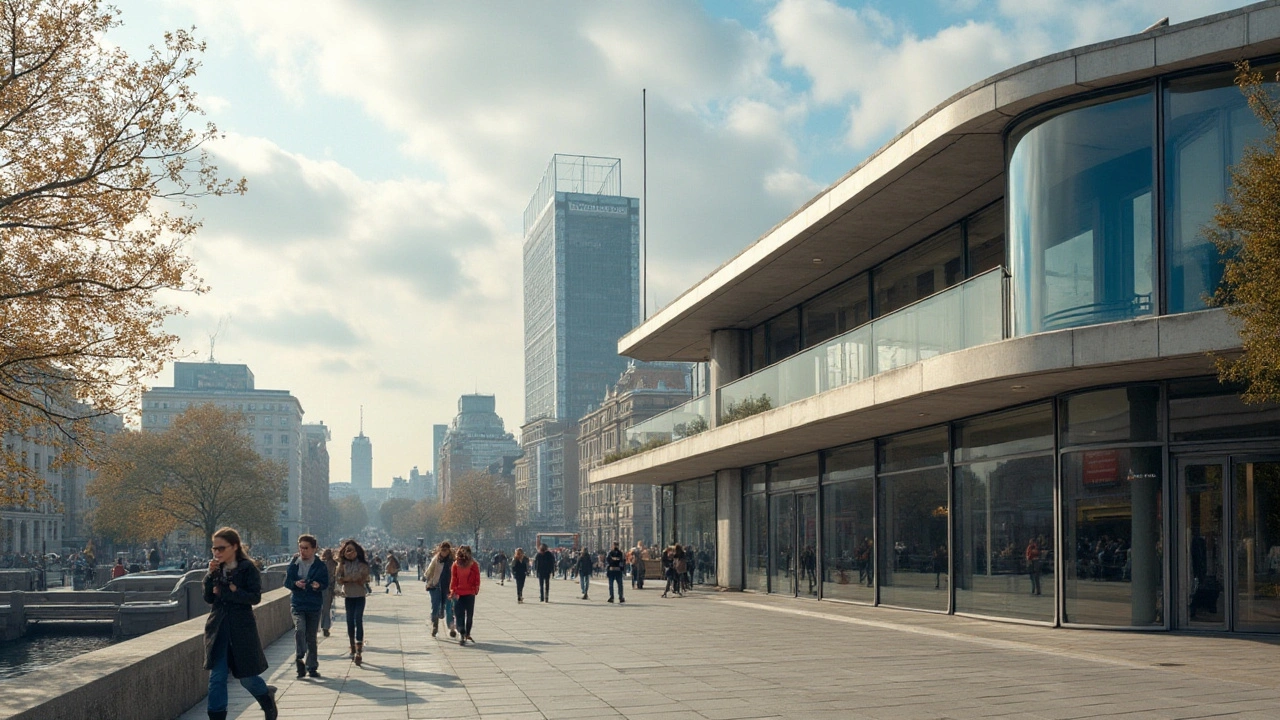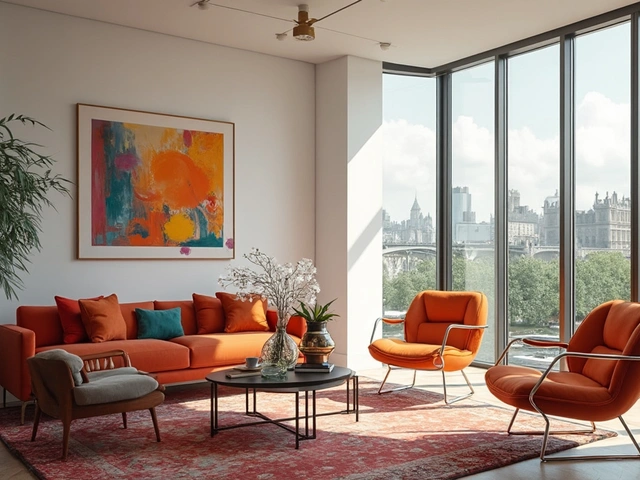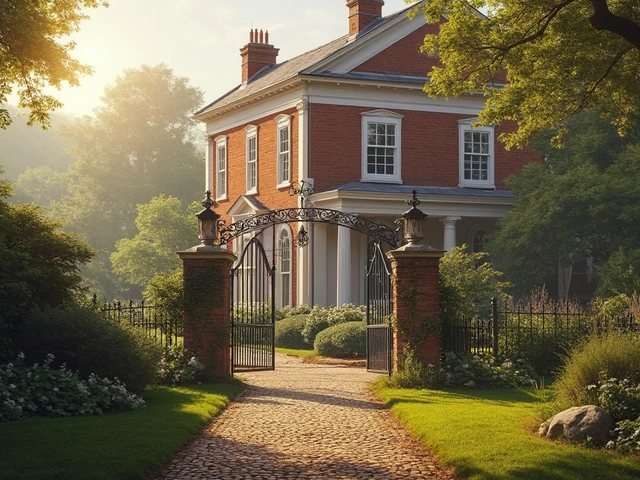The International Style marks an era of elegance in simplicity and coherence in urban planning. Born from the ideas of early 20th-century European architects, this movement revolutionized the way we view architecture today.
It is characterized by an emphasis on volume over mass, the use of lightweight, industrial materials, and the rejection of unnecessary ornamentation. By breaking away from traditional design conventions, it paved the way for a modern architectural vocabulary that speaks a universal language.
Whether you're an architecture enthusiast or curious about how global trends influence local environments, understanding International Style offers a fascinating glimpse into the evolution of contemporary design principles. This article invites you to explore its timeless appeal and consider how it continues to shape the spaces we inhabit.
- Origins of International Style
- Key Characteristics of International Style
- Influence on Global Architecture
- Cultural Adaptations in Design
- Iconic Examples Around the World
- Embracing the Style in Home Design
Origins of International Style
In the early decades of the 20th century, a profound shift was happening in the world of architecture and design. The International Style emerged as a result of this transformative time, with thinkers and creators striving to redefine the built environment. Tooling their creativity amidst the backdrop of post-World War I developments, architects like Le Corbusier, Walter Gropius, and Ludwig Mies van der Rohe became pivotal figures in pioneering this style. They sought to address the confluence of technological progress and the changing human need for space, advocating for designs that were stripped down to pure functionality, utilizing industrial materials such as steel, concrete, and glass. These architects visualized spaces that emphasized clarity, simple geometry, and openness, a stark contrast to the ornate and weighty designs that had preceded them.
Highly influential schools such as the Bauhaus in Germany played a crucial role in the development of International Style. Founded by Walter Gropius in 1919, the Bauhaus philosophy was a radical counterpoint to the status quo, focusing on harmony between the function of an object and its form. The teachings from this institution were instrumental in disseminating the ideas that would shape modern architecture worldwide. Le Corbusier’s 1923 publication, "Vers une architecture" (Toward an Architecture), argued for a new language in architecture that should reflect the industrial age, and his manifesto became one of the foundational texts that underpinned the International Style. His assertion that houses should be "machines for living" encapsulated the era’s drive to merge practicality with aesthetic rigor.
The first significant exhibition to define and affirm the International Style was the 1932 exhibition at the Museum of Modern Art in New York, curated by Philip Johnson and Henry-Russell Hitchcock. This exhibition was not merely a retrospective but a clarion call that identified and categorized the unique features that distinguished this new wave of architecture: an emphasis on volume over mass, the regularity over symmetry, and the renouncement of applied ornamentation. It was during this pivotal event that the term "International Style" was coined, setting the tone for architecture to come. As Johnson noted, these buildings were about space, not shape; transparency, not opacity. They were the physical reflections of a world stepping boldly into modernity, borne out of a desire to innovate and adapt.
"Architecture is the will of an epoch translated into space." - Ludwig Mies van der Rohe
This new architectural ideology resonated globally, blending seamlessly into the urban landscapes of many cities. With its core principles of functionalism, simplification, and newness, the International Style transcended cultural boundaries, influencing the design and construction of structures in diverse environments. Countries around the world embraced the ideas, realizing the potential to utilize these concepts within the context of their unique cultural identities. This adaptability is perhaps what ensured the enduring legacy of this style, allowing it to continuously evolve and respond to the needs and aspirations of societies over decades. The power of the International Style was not only in its aesthetic but also in its democratizing force—aesthetic accessibility available to all, not just the few.
Key Characteristics of International Style
The International Style is celebrated for its distinctive features that highlight functionalism, minimalism, and a global aesthetic. Unlike other architectural movements, the International Style doesn’t rely on decorative facades or traditional ornamentation. Instead, it embraces the notion of 'less is more', a concept famously articulated by one of its pioneers, Ludwig Mies van der Rohe. This phrase encapsulates the style's emphasis on uncluttered open spaces that prioritize functionality above all else.
A defining characteristic of the International Style is its focus on volume rather than mass. This approach creates an airy, open feeling in buildings, often employing large, unadorned surfaces and a streamlined form to accentuate space rather than physical presence. Transparency plays a significant role here, with extensive use of glass allowing buildings to blend with their environment. The exterior often reflects the true structure of the building, giving honesty to its construction method through visible steel frames and beams.
The materials used in International Style are another hallmark of its identity. Architects primarily choose industrial materials such as glass, steel, and concrete, which enable the creation of bold lines and simple, geometric forms. These materials serve both aesthetic and practical purposes, supporting the creation of buildings that are both beautiful and easy to maintain. The lack of ornate detailing not only simplifies repair and upkeep but also underscores the elegance in simplicity.
Standardization is also a key feature in this style, promoting efficient use of space and resources. Designs often incorporate modular elements that can be replicated, allowing buildings to be constructed with economy and scalability in mind. This approach not only supports mass production but also makes the International Style easily adaptable to different environments and cultural contexts. The style’s flexibility ensures it remains relevant, continually evolving while staying true to its core principles.
"The International Style simplifies design to its purest form, focusing on function rather than decorative complexity." - Philip JohnsonThis idea resonates deeply within the style, challenging designers to find the beauty in utility and straightforward design. Every aspect of a building, from the layout to the materials, serves a functional purpose, making the architecture both purposeful and aesthetically pleasing.
In contemporary times, the influence of the International Style can be seen in many modern buildings worldwide, standing as a testament to its enduring impact. From public spaces to private residences, its principles continue to inspire architects and designers to create environments that are both practical and universally appealing. As cities grow and evolve, the relevance of the International Style in promoting sustainable and efficient design becomes ever more significant.

Influence on Global Architecture
The reach of the International Style is extensive, and its impact on global architecture is undeniable. Emerging in the aftermath of World War I, this architectural movement sought to create a universal design language that could transcend national boundaries. The style prioritized functionality and stripped down forms, aiming for structures that were practical yet aesthetically pleasing. Its minimalist approach resonated with architects worldwide, eager to rebuild and modernize cities devastated by war.
One of the hallmarks of this style is its adaptability. Architects have applied its principles to a wide variety of projects, ranging from skyscrapers in bustling metropolises to private residences in suburban settings. The transparency and openness characteristic of International Style buildings allowed for an interaction with the surrounding environment, encouraging a harmony between the inside and outside spaces. This adaptability also meant that as architects in different countries embraced the style, they could adjust certain elements to better fit local climates and cultures, which made the style both unique and universally recognizable.
Icons of the style include Ludwig Mies van der Rohe's Seagram Building and Le Corbusier's Villa Savoye, both of which exemplify the movement's emphasis on clean lines, geometric forms, and the use of industrial materials. The Seagram Building, with its dark bronze exterior and understated elegance, became a model for corporate skyscrapers worldwide. Meanwhile, Villa Savoye, with its pilotis, horizontal windows, and open floor plan, redefined residential architecture by championing light and air.
"The mother art is architecture. Without an architecture of our own we have no soul of our own civilization." — Frank Lloyd Wright
This quote perfectly captures the sentiment that architecture is not merely about building structures but creating spaces that reflect the culture and aspirations of a society. The International Style has played a pivotal role in shaping the architectural identity of countless cities, from New York to Tokyo. Its principles have been adopted and adapted by architects worldwide, enabling them to create structures that meet contemporary needs while maintaining a timeless appeal. The impact of this style is evident in the skyline of every major city, showcasing its enduring influence and versatility.
Cultural Adaptations in Design
International Style, though grounded in universal principles, has been tailored to reflect the unique cultural tapestries of various countries. As it spread across the globe, architects began blending its core tenets with local materials, climates, and craftsmanship, creating structures that, while modern, resonated with indigenous heritage. This fusion not only enriched the original concepts but also instilled a fresh narrative into architecture, marrying international approaches with local traditions. In places like Japan, for instance, there was a harmonious blend of minimalist aesthetics inherent in both traditional Japanese architecture and International Style. This seamless integration is evident in the use of open spaces and geometric forms, highlighting a keen awareness of proportion and light.
Latin America's take on International Style, particularly in countries like Brazil, added vibrant local flavors to the mix. Here, the ubiquitous concrete used in modernist structures was sometimes juxtaposed with colorful tiles or organic forms that captured the exuberance of Brazilian culture. Architect Oscar Niemeyer, known for his unique curvature and innovative designs, articulated a distinctly Brazilian version of the International Style. He once stated,
"My ambition has always been to design buildings that celebrate abundance, desire, and joy—with not only firmness but also grace."His works, such as the Catedral de Brasilia, embody this blend beautifully, showcasing how local cultural elements can enhance architectural universality.
In India, the International Style morphed to accommodate the subtropical climate and cultural ethos. Influential structures like the Indian Institute of Management Ahmedabad, designed by Louis Kahn, exhibit how designers adapted ventilation and shading strategies to suit local weather conditions. By incorporating traditional Indian elements such as jaali screens for natural cooling, the architecture offers more than just aesthetic pleasure; it manifests practicality in a hot climate while respecting cultural origins. This modification reflects how adaptation doesn't merely occur on a visual level but operates functionally as well.
This style's incorporation into diverse cultural contexts has led to an exciting evolution in design, demonstrating the flexibility and global relevance of its principles. As cities continue to grow and change, the International Style provides a base from which architects can launch, offering endless possibilities for customization based on sociocultural needs. With each adaptation, the style collects new stories and nuances, painting a broader picture of human creativity. To truly grasp its impact, acknowledging this evolutionary journey is crucial, as it bridges communities and enhances our shared architectural heritage. In today's world, embracing these adaptations can lead us toward a form of design that respects history while embracing the present.
Iconic Examples Around the World
When exploring the profound impact of International Style, it's essential to highlight some of the most iconic structures that stand as testaments to this architectural movement's enduring appeal. From the sleek lines of American skyscrapers to minimalist European constructions, these buildings demonstrate the versatility and global reach of this style.
One cannot discuss International Style without mentioning the influence of the German architect Ludwig Mies van der Rohe. His work on the Seagram Building in New York City, completed in 1958, embodies the style's ethos of unadorned structural forms and the use of industrial materials. Clad in bronze and glass, the building is admired for its elegant simplicity and functional design. This skyscraper not only epitomizes a new urban aesthetic but also reflects the economic optimism of post-war America. It's no surprise that Mies van der Rohe famously stated, “Less is more,” capturing the essence of this design approach.
Another remarkable example is the Villa Savoye in Poissy, France, by Swiss architect Le Corbusier. Completed in 1931, this residence serves as a manifesto for Le Corbusier's 'Five Points of Architecture', which became a guiding principle for the style. The villa's emphasis on open spaces, pilotis (supports), and horizontal windows exemplifies how the International Style harmonizes with nature while breaking away from traditional architectural restrictions. The Villa Savoye demonstrates the style's ability to integrate form with function seamlessly, catering to both aesthetic and practical needs.
Across the ocean, the Sydney Opera House stands as a cultural icon of modern architecture, although it strays into a more organic interpretation of International Style. Designed by Danish architect Jørn Utzon, and completed in 1973, its unique sail-like shells defy classical design constraints while embracing innovative engineering techniques. Though controversial during construction, it now symbolizes Australia's cultural and artistic identity. Its presence underscores the idea that International Style can be molded to reflect the cultural nuances of its location.
The Farnsworth House, also by Mies van der Rohe and located in Plano, Illinois, USA, represents another pure form of the style. The house’s glass walls blur the boundaries between inside and outside, immersing its inhabitants in the surrounding landscape. Finished in 1951, the structure's minimal material palette and open plan layout revolutionized residential architecture. Its transparency and lightness stand, quite literally, as evidence of how far materials technology advanced thanks to this architectural revolution.
Each of these structures exemplifies how International Style serves as a framework adaptable to various cultural landscapes while maintaining a focus on simplicity, functionality, and the honest use of materials. These buildings continue to inspire current architectural practices and remain relevant in discussions about modern design. The simplicity and elegance they present invite observers to consider how architecture can both reflect and influence the social zeitgeist.
Embracing the Style in Home Design
In today’s world, where homes have become more than just living spaces, International Style provides a refreshing approach for those seeking clean lines, functional spaces, and a sense of openness. This architectural movement can be delicately yet distinctly incorporated into home design, favoring minimalism and functionality without sacrificing elegance. The beauty of this style lies in its simplicity: homes that adhere to these principles often feature open floor plans that create a seamless flow between rooms. Large glass windows are another hallmark, allowing natural light to flood the interiors, which not only reduces energy costs but also ties indoor spaces to the surrounding environment.
One of the compelling aspects of this style is the strategic use of industrial materials such as steel, glass, and concrete, which can transform any mundane room into a space of sophistication and modernity. For many homeowners, adopting this style means embracing a lifestyle that values quality over quantity. Simple, functional furniture and subtle color palettes emphasize the home's structural beauty rather than cluttering it with excessive decorations. As architect Ludwig Mies van der Rohe said, "Less is more." Homes designed with these principles exude an aura of calm and order that many find appealing in our increasingly chaotic world. Implementing this in your home doesn't require a complete overhaul but can be as simple as focusing on layout changes that reflect its aesthetic.
Incorporating global design trends like these into a home involves both inspiration and practicality. Start with choosing a primary neutral color for your walls, which acts as a blank canvas for creating a simpler visual environment. Use furniture with sleek, unadorned lines to maintain the unpretentious nature of the style. When decorating, opt for functional art pieces and avoid excessive decor, as this can distract from the spatial efficiency that is central to the movement. Indoor plants can add a touch of nature and life to stark spaces while providing a bridge to the outside world. The art of balancing warmth with minimalism is crucial here and can be achieved through the use of texture, such as mixing wooden and metallic elements.
It’s fascinating to note the statistical rise in the popularity of this design approach. A recent survey published in "Architectural Digest" suggests that about 27% of new homeowners prefer a minimalist, open-floor plan inspired by International Style. In fact, the influence of such a style can be seen not only in private homes but in urban lofts and apartment complexes around the globe. This wide-reaching appeal highlights its adaptability across various cultural and architectural settings. Despite the initial investment, many find the long-term benefits—both aesthetically and economically—worthwhile. As urban areas become more compact, the need for efficient yet beautiful living spaces continues to soar.
The flexibility of adopting such a style extends its relevance and adaptability, transcending beyond geographical boundaries. In newer homes, where sustainability is becoming a priority, this style can be integrated with green technology such as solar panels and energy-efficient appliances, enveloping a truly modern, eco-friendly aesthetic. These modern adaptations align with the ethos of the original movement, which was about crafting a modern identity from new possibilities and materials. Whether your aim is to revamp your current environment or you’re designing a space from scratch, adopting these principles will certainly make it distinctly yours while retaining global influences.





